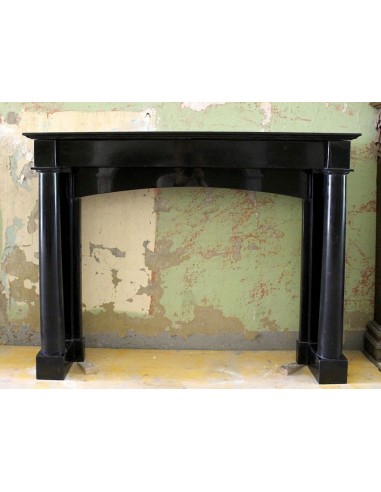ANTIQUE EMPIRE-STYLE FIREPLACE (so we are in the early nineteenth century) IN EXCELLENT CONDITION OF CONSERVATION, PARIS PROVENANCE, MODEL AS CLASSIC AS IT IS INTROVABLE, ESPECIALLY WHEN DRAWED IN THE MOST PRECIOUS AND AFFASCINATING BLACK MARBLE OF THE EARTH GLOBE.
This mantel is in Belgian Black marble, among the marbles of this color the noblest, certainly the most prized and in demand (not least because the quarry is running out, the prices have gone crazy, gone off on a tangent that there is no telling where it will take them, and when something costs EXAGERATELY the women and architects fall madly in love with it).
We are in the Empire period, we are at the time when the French Grandeur was being reborn and reinvigorated, a period in which it was inevitable to give preference to native marble, that is, French quarried marble, and Belgium had been conquered only a few years before, so the quarry that produced the most fascinating black marble of the way was… French...
But there was another and contingent reason: As you will know (if you don't know it is because you have not read EVERY part of my site and for that you will be punished..), the vast majority of chimneys (at least the 19th century ones) were made in Italy.. The French had no schools of sculpture, we did (founded by the Romans over two thousand years ago).
We could glory in Pietrasanta, Carrara, the whole of Lunigiana (Italy), a huge artistic and artisanal heritage located at the foot of the Apuan Alps from which cunning French patrons drew heavily and paid two liras for sublime sculpture works.... IN SHORT, WE ITALIANS THINK WE ARE SO CLEVER WHILE, NO MORE AND NO LESS, WE WERE THEIR.... CHINESE!!!
But I'm deviating, so let's get back to the main topic: This fireplace, because of its deliberate linearity, did not need a Cellini or a Michelangiolo to be made, the French sculptor was enough, and so it often happened that this particular Impero model was produced in France, in this specific case in Belgium now a French province.
LAST NOTE: This fireplace is “small” (at least for the era in which it was sculpted) in that it was located in a bedroom at the time...
I like to point out how, until the Empire period, in the bedrooms fireplaces were placed only by the nobility or the Scrooge McDuckers, while precisely in those early years of the nineteenth century the bourgeoisie (the European one, in Italy the advent of the bourgeoisie will be delayed about another century) appears on the balcony of a new wealth and can therefore also afford certain “musts” until a few years before reserved for a select few.














































